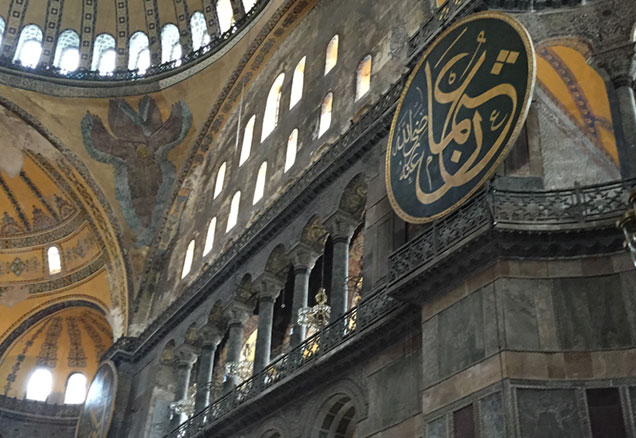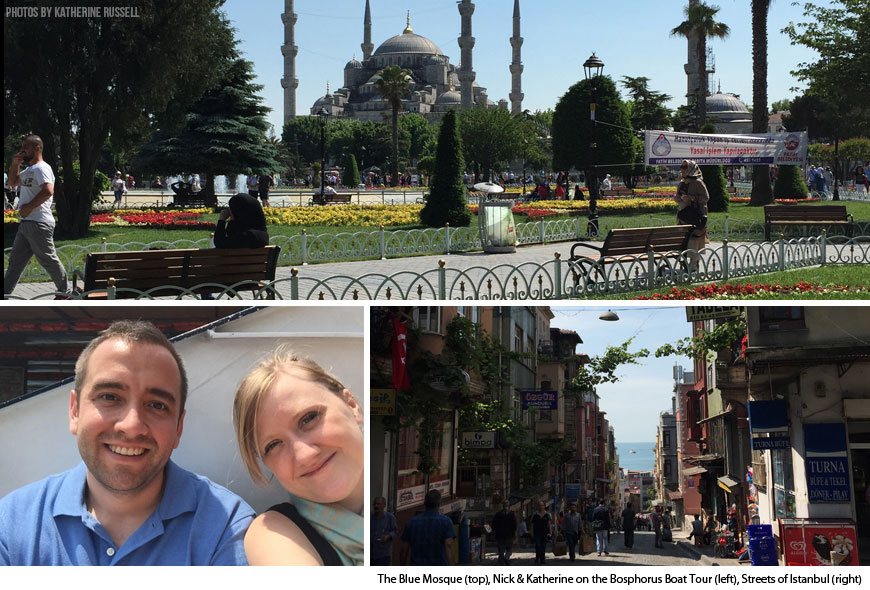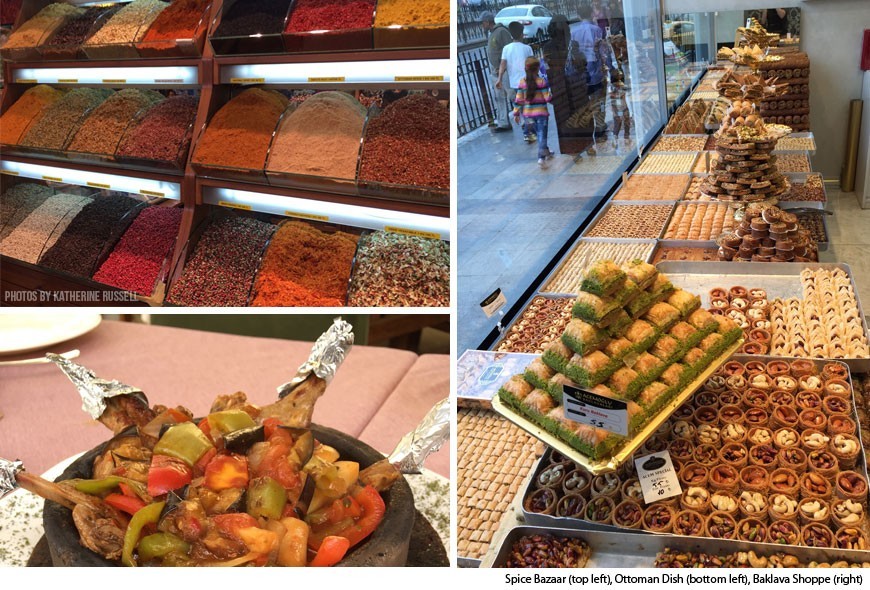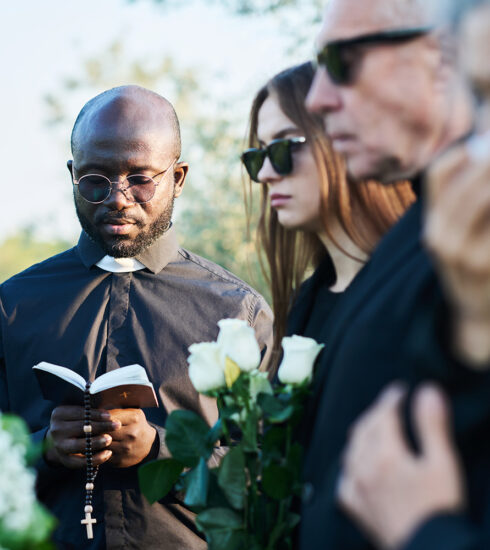Reflections of a millennial couple in Istanbul
Finding the “Real” Istanbul
On the second floor of a stone building, directly outside the Istanbul old Grand Bazaar, there is a man who sells rugs. His family has collected them for seven generations: Kurdish wool in muted, sandy colors; intricate Ottoman patterns woven from shimmering silk; antique tribal rugs; and bright Anatolian dowry pieces. He carries on the art of commerce that is so ingrained in Istanbul culture, which evolved at the crux of the ancient Silk Road and the Bosphorus.
Selling rugs is not an unusual occupation in Turkey, but for tourists like my husband Nick and me, the buying process was a step into age-old traditions.
Nick and I embody the yin-and-yang of travel: he, the relaxed yet ever-thoughtful pragmatist, and me, the seeker of unhindered, “authentic” experience. I like to search out the genuine parts of a city and its people, experience the culture in a truthful way, and I resent being seen as just another tourist. Nick, on the other hand, unabashedly accepts his Americanisms and tends to go with the flow without forcing anything to happen. I spent six months before our honeymoon studying Turkish and listing everything we had to cover. Buying a rug – or pretending we actually had the money to buy a rug – was on that list.
On our first full day in Istanbul, I bought a silk pashmina. The seller operated from a room of about eight square feet, with vibrant cashmere scarves folded meticulously and stacked right to the ceiling. He seemed young enough not to be jaded by the persistent tourists or his unwavering competitors, and with a friendly smile, he fumbled to show me how to tie a special knot around my neck that looked like a rose. Nick and I were too charmed to attempt to drive down the price.
We were only a few steps out of his shop when another young man approached us, having witnessed our quick purchase, and proposed, “My uncle runs a rug store. Would you like to see? No need to buy – he just likes to show them.”
I heard a low mumble from Nick, but I quickly agreed. I’d read about the ancient art of rug bargaining, so of course I was prepared to negotiate on my first day (maybe).
The man led us down cobbled alleyways, passing vendors carrying massive trays of simit – a circular bread crusted with sesame seeds – and excited tourists posing beneath their selfie sticks. Pure juxtaposition of old and new tradition.
“Where are you from?” our new friend asked.
“New York,” we replied. Buffalo, to be exact, but New York is descriptive enough.
“Excellent,” he said. He quickened his step.
At that, I knew exactly what we were to him: two bumbling tourists from “New York” (which automatically translates to New York City to most outsiders) who probably paid far too much for a pashmina and would pay far too much for a rug, too.
We entered an unlit foyer with two old men playing backgammon on short stools and puffing cigarettes. They didn’t turn to look at us. The walls were beaten with time, and it smelled of dust and long conversation.
Nick and I exchanged cautious glances. He was ready to go Liam Neeson on the situation because he was convinced we were about to get mugged – which wasn’t an unreasonable thought. We shuffled up a flight of stairs and entered a bright room with dozens of rolled up rugs. Several large pieces hung from the walls, and we gasped at the sight of them. The hours, attention, and practice someone had to put into weaving those designs!
We sat on a French sofa, and the man offered us tea. I came to deeply appreciate this custom, practiced by many Turkish vendors – it makes shopping and bargaining seem like an act of camaraderie more than a swindling by either party. Even if you drink it, there is no obligation to buy something.
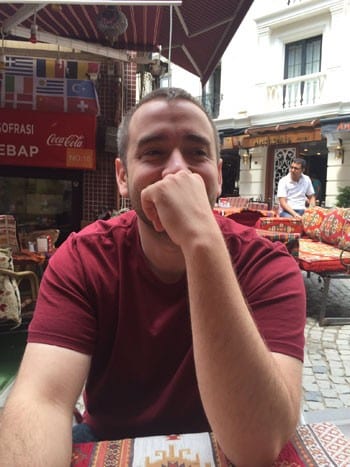
“Are you sure? It’s bitter,” the assistant explained.
“That’s what I like,” I insisted, believing my tastes made me look less like a tourist.
That was when the man’s “uncle” entered. His name was Deniz. He was perhaps in his mid-40s, had a bulging belly and a round yet shrewd face. He could read a tourist’s mind inside out. He greeted us and shook our hands, then sat cross-legged and confident in a chair next to us.
This is the part where he sized us up. He asked where we’re from, if we’d been to Turkey before, and how long we’d been here.
America, first time, and one day: check one, two, and three. He immediately called his assistant to start rolling out $10,000 rugs to show us.
Nick was swift to ask how much they cost, and a sour look crossed Deniz’s face. He wanted to sell the rugs to us before he talked prices, but he named them anyway. $8,000 for a small 3×5. Nick responded exactly how a negotiator is supposed to respond (or so I’d read in my handy travel guide): he made a displeased face and said, “Hmm…”
I knew this was Nick’s polite way of letting a pushy vendor down easy, but unbeknownst to him, it’s a classic bargaining technique in Turkey.
The price quickly dropped to $2,000, since we were Deniz’s first customers that morning. Turkish vendors have a superstition that the first customer will determine your luck for the rest of the day.
Still, Nick was upfront about his intentions. “It’s our first day here. We really don’t plan on spending a lot of money, or any money…” he kept explaining. I giggled behind my teacup.
Deniz seemed more dissatisfied with our taste in rugs than our ability to pay for them. He started rolling out wool ones, knocking the price to $600. While I was enjoying the carpet show, Nick had started to sweat.
“We just can’t spend that,” he admitted again.
The price dropped to $400, with an additional rug thrown in free of charge.
I chuckled at Nick’s inadvertent impression on Deniz. He genuinely didn’t want to buy a carpet to lug around on the first day of a three-week honeymoon, but Deniz was reading him as an expert negotiator.
About fifteen minutes had passed and we’d drained our glasses to the last drop of tea. We didn’t want to waste any more of Deniz’s time.
I said, “We would like to come back next week, after we have seen a little more of the city.” It wasn’t a lie, but vendors in Istanbul know well enough that if a sale isn’t immediate, it won’t happen at all.
“It’s just not in our budget…” Nick trailed off apologetically.
Deniz paced, running his hands through his hair. There was a brief pause before he blurted, “You want this rug for less than $400? Well, fuck off!”
We stood there, stunned for a moment.
“You’re not from New York. You’re too cheap to be from New York!” Deniz cried.
“Well we…” I stammered, feeling exposed. Had we led him on? Nick grasped my hand and we got out of there.
It’s difficult to define this search for the “authentic experience.” As a foreigner, everything I do here will always be inherently touristy. Not all rug dealers or bazaar vendors will treat customers that way. Many will spot you from ten yards, dash up to you, and say delightful things like, “Yes, please?” or “Come, pleasure your eyes!” Most will be kind and welcoming and used to the word no. It dampened any delusions I had about “not being an average tourist.”
I came to realize that the authentic experience is difficult to find when you are seeking it out. It may cause you to overlook the authenticity of sites on the beaten path like the grandiose Aya Sofia with layers of history peeling off the walls, the breathtaking blue tiles of the Sultanahmet Mosque, the barefoot walks through the tombs of sultans, the colorful and fragrant heaps of saffron and pepper at the Spice Bazaar, the mystical whirling dervishes, or a tour into the ancient, cave-like Basilica Cistern.
Maybe authentic experience comes from the people you meet while wandering. Nick and I got off at the wrong metro stop on our way to Kadiköy (the Asian side of Istanbul) and escaped the rain into an empty restaurant. The owners spoke no English, so they led us to their stove in the back and pulled the lids off their pots and pans and asked us to point to the food we wanted. (To which Nick replied, in a way I love most about him, “All of it”).
Later I asked them, “Pazar yeri ürün nerede?” –Where is the produce market? The owner’s daughter waited at the minibus stop with us and made sure the other passengers knew to help us out. (We still ended up at the wrong market!) Human kindness is everywhere.
Others may say authentic experience comes from what you’re able to observe. The taxi vans with intricate rugs rolled down the aisle between their seats; the blaring call to prayer, an atonal invocation that rings through the streets five times each day; the people enjoying keyif (“quiet relaxation”) in tea gardens on every block; the bakeries making the softest brick oven bread every morning and afternoon; the local men swimming off the rocks into the Marmara Sea, and a woman in full hijab leaning against a motorcycle and watching; the stray cats and dogs everywhere that are oddly clean and well-fed because the community takes care of them; the waiters who pause to listen to the news on politics and turmoil at the Syrian border. From these little sights, Nick and I learned of Istanbul’s values.
Or maybe true connection with a different culture comes when you accept the fact that you are a “bumbling” tourist and play the role of a student, the clueless fool, the one accidentally mispronouncing Turkish and juggling a map and a camera and bags full of souvenirs because you just can’t get enough of this place. After just a few days or couple weeks, you’ll go home and drive your friends crazy talking about your city’s need to open tea gardens and practice keyif.
No matter how we found our true experiences, we took a part of Istanbul home with us, and it will resonate for the rest of our lives. Those memories will be authentically ours.




